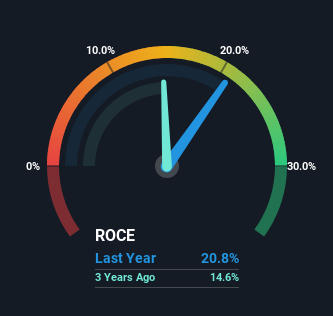
If we want to find a potential multi-bagger, often there are underlying trends that can provide clues. Amongst other things, we'll want to see two things; firstly, a growing return on capital employed (ROCE) and secondly, an expansion in the company's amount of capital employed. Ultimately, this demonstrates that it's a business that is reinvesting profits at increasing rates of return. Speaking of which, we noticed some great changes in Tingyi (Cayman Islands) Holding's (HKG:322) returns on capital, so let's have a look.
What Is Return On Capital Employed (ROCE)?
If you haven't worked with ROCE before, it measures the 'return' (pre-tax profit) a company generates from capital employed in its business. To calculate this metric for Tingyi (Cayman Islands) Holding, this is the formula:
Return on Capital Employed = Earnings Before Interest and Tax (EBIT) ÷ (Total Assets - Current Liabilities)
0.21 = CN¥4.4b ÷ (CN¥56b - CN¥35b) (Based on the trailing twelve months to June 2024).
Therefore, Tingyi (Cayman Islands) Holding has an ROCE of 21%. In absolute terms that's a great return and it's even better than the Food industry average of 8.9%.
Check out our latest analysis for Tingyi (Cayman Islands) Holding

In the above chart we have measured Tingyi (Cayman Islands) Holding's prior ROCE against its prior performance, but the future is arguably more important. If you're interested, you can view the analysts predictions in our free analyst report for Tingyi (Cayman Islands) Holding .
What Can We Tell From Tingyi (Cayman Islands) Holding's ROCE Trend?
We're pretty happy with how the ROCE has been trending at Tingyi (Cayman Islands) Holding. We found that the returns on capital employed over the last five years have risen by 47%. That's a very favorable trend because this means that the company is earning more per dollar of capital that's being employed. Speaking of capital employed, the company is actually utilizing 24% less than it was five years ago, which can be indicative of a business that's improving its efficiency. If this trend continues, the business might be getting more efficient but it's shrinking in terms of total assets.
For the record though, there was a noticeable increase in the company's current liabilities over the period, so we would attribute some of the ROCE growth to that. Effectively this means that suppliers or short-term creditors are now funding 62% of the business, which is more than it was five years ago. Given it's pretty high ratio, we'd remind investors that having current liabilities at those levels can bring about some risks in certain businesses.
What We Can Learn From Tingyi (Cayman Islands) Holding's ROCE
In the end, Tingyi (Cayman Islands) Holding has proven it's capital allocation skills are good with those higher returns from less amount of capital. Since the stock has only returned 31% to shareholders over the last five years, the promising fundamentals may not be recognized yet by investors. So with that in mind, we think the stock deserves further research.
One more thing, we've spotted 1 warning sign facing Tingyi (Cayman Islands) Holding that you might find interesting.
If you'd like to see other companies earning high returns, check out our free list of companies earning high returns with solid balance sheets here.
Have feedback on this article? Concerned about the content? Get in touch with us directly. Alternatively, email editorial-team (at) simplywallst.com.
This article by Simply Wall St is general in nature. We provide commentary based on historical data and analyst forecasts only using an unbiased methodology and our articles are not intended to be financial advice. It does not constitute a recommendation to buy or sell any stock, and does not take account of your objectives, or your financial situation. We aim to bring you long-term focused analysis driven by fundamental data. Note that our analysis may not factor in the latest price-sensitive company announcements or qualitative material. Simply Wall St has no position in any stocks mentioned.